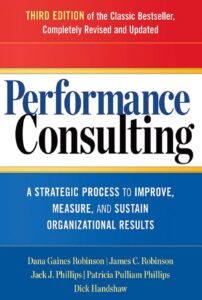Ensuring training is effective is a key part of any learning and development professional’s work. However, this can be easier said than done if you are viewed as an ‘order taker’ by senior staff. People in senior roles may not be accustomed – or have allowed time for – push back on their ideas. When it comes to training, their ideas all-too-often revolve around ‘Everyone needs to know about X!’ with little further thought as to why, let alone how knowing X relates to business change.
How performance consulting benefits learning and development
Performance consulting is a great way to handle this situation. It’s an outcome-focused methodology that focuses on what success looks like and how to get there. As well as getting your organisation the results it needs, it gives you business-focused language to use with senior colleagues, and techniques they will recognise.
This can be a huge boost for your career and for the reputation of the learning and development team. No longer are you order takers – you’re now solution finders and integral to the organisation’s success.
As a bonus, performance consulting enables one to push back while maintaining good relationships with senior colleagues – for example, if a request won’t bring about change. The model can be used to show how developing training won’t provide the answer they’re looking for and point to where effort needs to be focused.
What is performance consulting?
Performance consulting is strategic. It’s based around identifying a goal or an opportunity, assessing the performance needs associated with this, and implementing solutions that address these needs and enable the organisation to reach its goal.
Learning and development teams fit in most obviously at the performance needs point. But to be most effective – and for your training to support the organisation’s goals – it’s best to be involved as early in the planning as possible.

What does performance consulting for training look like?
I like to use a four-stage process from one of my favourite books by Dana & Jim Robinson, ‘Performance consulting: a strategic process to improve, measure, and sustain organizational results’. The third edition of Performance Consulting, coauthored with Drs Jack and Patti Phillips and Dick Handshaw, was released in the Spring of 2015. If you’re keen to try out a performance consulting approach, I’d recommend getting hold of a copy.
It starts by identifying a goal or strategic opportunity. This may have been done for you by senior colleagues but ideally there’ll be someone from L&D involved to nip those ‘We need a course’ conversations in the bud.
If that person is you and you find it difficult to challenge senior colleagues, remember that Cathy Moore (author of Map It and another of my favourite authors) also had this problem, so you’re in good company. Cathy offers some brilliant suggestions (and a script!) on how to do this while maintaining good relationships with stakeholders in her book. The key is to avoid committing to a solution at this point – especially if it involves training. As Cathy says: ‘Ban the word “course” from your vocabulary.’
It’s worth focusing on those working relationships from the start. Make sure you know who the people are who will affect your project – including those who could scupper it if not kept in the loop.
Once you’ve established where you’re going, it’s time to work out how you’ll know when you have got there by assessing business and performance needs. In other words, you’re asking ‘What does good look like?’ and ‘Why is there a gap between what good looks like and where we are currently?’
According to the Robinsons, there are three ways to do this:
- A ‘Should’ assessment explores what organisational results are needed and what people need to do to achieve them
- An ‘Is’ assessment looks at how things currently are
- A ‘Cause’ assessment analyses the root causes of the gap between the ideal and reality
At this point, you’ll have data you can use for the next phase, implementing and measuring solutions.
The ‘implement’ part is the one that most L&D team members are familiar with. The data gathered will help you propose a real solution to the organisation’s problem and back it up with evidence.
It’s also essential to develop a way of measuring success at this stage. This way, you can tailor the measurement tool to the situation and ensure it is rigorous enough to use for later decisions. For example, if your solution focuses on changing behaviour, you’ll need to find a way to check that the desired change has happened. Will that be through a questionnaire, management reporting or another method?
You’ll also want a mechanism for measuring return on investment (ROI) at this point. This will help identify whether it’s cost effective to develop and implement the change you’re proposing. It is best to rethink your approach if your proposed change will cost more than the saving it will generate, or the numbers aren’t clear.
I’ve written a free guide to measuring ROI – drop me a line if you’d like a copy.
The next step, once your change has been implemented, is measuring it. Measurement doesn’t always mean the end of a project – your data may reveal an ‘unknown unknown’ that you didn’t factor in and that is affecting success. By measuring, you’ll be able to tweak your offering.
Performance consulting is a powerful tool that not only delivers training that gets enduring results for the organisation but for L&D professionals themselves.
Contact us to find out more about successful performance consulting for training in your organisation.

